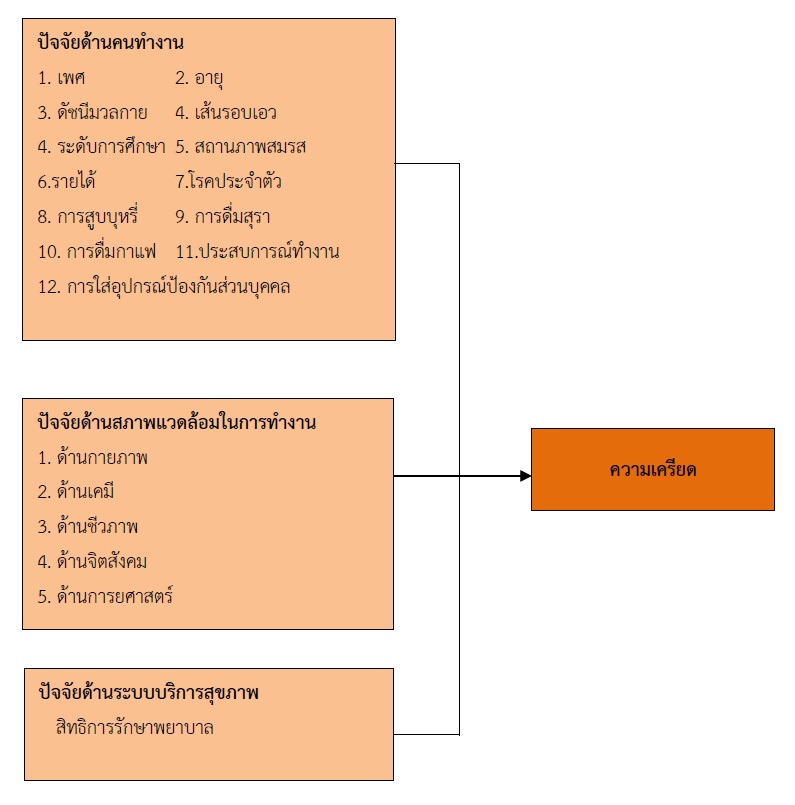ความชุกของความเครียด และปัจจัยที่สัมพันธ์ต่อความเครียดของพนักงานผลิตอิฐก่อสร้าง จังหวัดนครศรีธรรมราช
คำสำคัญ:
ความเครียด, พนักงานผลิตอิฐก่อสร้าง, สิ่งแวดล้อมการทำงานบทคัดย่อ
การวิจัยเชิงสำรวจแบบตัดขวางนี้เพื่อศึกษาความชุก และปัจจัยที่สัมพันธ์ต่อความเครียดของพนักงานผลิตอิฐก่อสร้าง กลุ่มตัวอย่างคือพนักงานผลิตอิฐก่อสร้าง จังหวัดนครศรีธรรมราช จำนวน 140 คน เก็บข้อมูลระหว่างตุลาคม ถึงธันวาคม 2562 เครื่องมือวิจัย ได้แก่ 1) แบบสอบถามข้อมูลส่วนบุคคล 2) แบบประเมินการสัมผัสปัจจัยคุกคามสุขภาพจากการทำงาน มีค่า CVI เท่ากับ 0.85 ค่าสัมประสิทธิ์แอลฟาครอนบาค เท่ากับ 0.80 และ 3) แบบประเมินความเครียด ค่าสัมประสิทธิ์แอลฟาครอนบาค มากกว่า 0.70 วิเคราะห์ข้อมูลโดยสถิติพรรณนา การทดสอบค่าไคสแควร์ และการวิเคราะห์การถดถอยโลจิสติกแบบทวิ (Binary Logistic Regression) ผลการวิจัยพบว่า
ร้อยละ 62.90 ของกลุ่มตัวอย่างมีความเครียดระดับสูงถึงรุนแรง ปัจจัยที่มีความสัมพันธ์ต่อความเครียด อย่างมีนัยสำคัญทางสถิติ ประกอบด้วย 1) ปัจจัยส่วนบุคคล ได้แก่ อายุ ระดับการศึกษา ดัชนีมวลกาย การดื่มสุรา และการดื่มกาแฟ และ 2) ปัจจัยสิ่งแวดล้อมจากการทำงาน ได้แก่ สิ่งแวดล้อมด้านกายภาพ ด้านชีวภาพ และด้านจิตสังคม โดยตัวแปรที่เป็นปัจจัยเสี่ยงต่อระดับความเครียดของพนักงานผลิตอิฐก่อสร้าง ประกอบด้วย ดัชนีมวลกายระดับอ้วน (AOR =10.19, 95%CI: 3.09, 33.57) การสัมผัสสิ่งแวดล้อมด้านกายภาพระดับปานกลางและระดับสูง (AOR =42.68, 95%CI: 6.92, 263.19) และ 7.58, 95%CI: 1.07, 53.34) และการสัมผัสสิ่งแวดล้อมทางจิตสังคมระดับสูง (AOR = 7.83, 95%CI: 1.06, 57.56) อย่างมีนัยสำคัญทางสถิติ
ดังนั้น เพื่อส่งเสริมและปกป้องสุขภาพของพนักงานผลิตอิฐก่อสร้าง พยาบาลอาชีวอนามัย รัฐบาล เจ้าของสถานประกอบการ และบุคลากรที่เกี่ยวข้องควรออกแบบกิจกรรมส่งเสริมและปกป้องสุขภาพของพนักงาน สนับสนุนการดูแลตนเองเพื่อควบคุมดัชนีมวลกาย และสร้างสิ่งแวดล้อมการทำงานด้านกายภาพ และจิตสังคมที่เอื้อต่อสุขภาพของพนักงาน
เอกสารอ้างอิง
Chanprasit, C., Kaewthummanukul, T., Songkham, W., & Chareonsup, Y. (2010). Health Hazards Identification, Health Status, Workrelated Injury and Illness Situational Analysis in Wooden Furniture Enterprises. Nursing Journal, 37(1), 1-14. (in Thai)
Chintanapamote, K., & Sittisarunkul, P. (2019). Physiology of Stress in the Aspect of Job Stress and Coping in Medical Professional. Journal of Medicine and Health Sciences, 26(2), 112-123. (In Thai)
Das, B. (2014). Prevalence of Work-Related Musculoskeletal Disorder among the Brick Field Workers of West Bengal, India. Archives Environmental Occupational Health, 69(4), 231–240.
Department of Industrial Works. (2019). Industrial Information for Staff. Retrieved June 20, 2022 from http://reg. diw.go.th/executive/amp2.asp?amp=1&prov =80 (in Thai)
Department of Industrial Works. (2021). Statistics of Industrial Factories That Have Been Permitted to Operate, Expand and Liquidate in the Years 2020-2030 and Cumulative Statistics of Industrial Factories at the end of That Year. Retrieved June 20, 2022 from https://www.diw.go.th/webdiw/static-fac/ (in Thai)
Department of Mental Health, Ministry of Public Health. (2016). Suanprung Stress Test-20. Retrieved June 16, 2022 from http://www.dmh.go.th/test/ stress/. (in Thai)
Devi, K. & Kiran, U. (2016). Occupational Stress among Brick Kiln Workers Interaction of Demographic Variable. International Journal of Research in Social Science, 6(2), 279-292.
Joshi, S. K., Dahal, P., Poudel, A. & Sherpa, H. (2013). Work Related Injuries and Musculoskeletal Disorders among Child Workers in the Brick Kilns of Nepal. International Journal of Occupational Safety and Health, 3(2), 2-7.
Kawakami, T., Khai, T. T. & Kogi, K. (2012). Research That Can Support Self-Help Initiative of Local Farmers to Improve Safety & Health at Work: Birth & Growth of WIND Training Program in Viet Nam. Journal of Safety, Health and Environmental Research Archive, 8(1), 11-18.
Krejcie, R. & Morgan, D. W. (1970). Determining Sample Size for Research Activities. Education and Psychological Measurement, 30(3), 607-610.
Lay, A. M., Saunders, R., Lifshen, M., Breslin, C., LaMontagne, A., Tompa, E. & Smith, P. (2016). Individual, Occupational, and Workplace Correlates of Occupational Health and Safety Vulnerability in a Sample of Canadian Workers. American journal of industrial medicine, 59(2), 119-128.
Machado, A., Herrera, A. J., de Pablos, R. & Espinosa-Oliva, A. M. (2014). Chronic Stress as a Risk Factor for Alzheimer’s Disease. Reviews in the Neurosciences, 25(6), 785-804.
Magnavita, N., Capitanelli, I., Garbarino, S. & Pira, E. (2018). Work-Related Stress as a Cardiovascular Risk Factor in Police Officers: a Systematic Review of Evidence. International Archives of Occupational and Environmental Health, 91(4), 377-389.
Mazokopakis, E. E. (2019). Occupational Safety and Health among Brick Workers in the Old Testament (Pentateuch). Annals of Global Health, 85(1), 1-2.
Najar, S. A., Zargar, W. A., Manzoor, S., Bashir, A. & Khan, B. A. (2021). Living Conditions of Informal Workers: A Sociological Study of Brick Kiln Workers in District Budgam of Kashmir Valley. Temida, 24(2), 217-237.
Nguyen, T. P. & Khai, T. T. (2014). An Evaluation of the Participatory Action-Oriented Training (PAOT) Program in Small Enterprises in Vietnam. Journal of Occupational and Health, 56(4), 309-316.
Samai, T., Jewpattanakul, Y. & Phetphannsee, S. (2015). The Relationships Between Personal, Socioeconomic and Stress Factors on Alcohol Drinking Behavior of Dweller in Bangkoknoi district, Bangkok. Journal of Nursing Science, 33(1), 42-50.
Sanjel, S., Khanal, S. N., Risal, A., Thygerson, S. M. & Joshi, S. K. (2016). Psychosocial Factors Associated with Occupation: A Comparative Study Between Brick Kiln and Grocery Workers. International Journal of Occupational Safety and Health, 6(2), 13-20.
Sawangwan, I. & Jariya, W. (2021). Factors Affecting the Stress in Working among Myanmar Construction Workers in Muang District, Chiang Mai province. Thai Science and Technology Journal, 29(4), 675-687. (in Thai)
Shrestha, S. & Thygerson, S. M. (2019). Brick Kilns of Nepal: a Non-Governmental Organization Perspective. Open Journal of Safety Science and Technology, 9(1), 1-6.
Thamlikitkul, S. & Sinudompol, S. (2016). Losing Weight of Obese Nursing Students at Kuakarun Faculty of Nursing in Navamindradhiraj University. Kuakarun Journal of Nursing, 23(2), 7-30. (in Thai)
Thanee, N. (2021). Relationship Between Perceived Health Beliefs and Self-Prevention Behaviors of Brick Producers. Warinchamrab, Ubon Ratchathani. UMT Poly Journal, 18(1), 648-662. (in Thai)
Thitaree, K. & Chaiwong, W. (2019). A study on Prevalence of Work-Related Stress and Relating Factors among Staff in a Private Hospital. Thammasat Medical Journal, 19(1), 115-132. (in Thai)
Thygerson, S. M., Sanjel, S. & Johnson, S. (2016). Occupational and Environmental Health Hazards in the Brick Manufacturing Industry in Kathmandu Valley, Nepal. Occupational Medicine & Health Affairs, 4(5), 2-7.
Unlamai, N., Thermtiptaweekul, K. & Chienwattanasook, K. (2018). Stress Management in the Workplace to Maximize Employee Efficiency. Journal of Management Science Nakhon Pathom Rajaphat University, 5(1), 104-117. (in Thai)
World Health Organization. (2001). The Role of the Occupational Health Nurse in Workplace Health Management. Retrieved June 10, 2022 from https://apps.who.int/iris/handle/10665/108433
World Health Organization. (2018). The Determinant of Health. Retrieved January 22, 2022 from http://www.who.int/hia/evidence/doh/en/

ดาวน์โหลด
เผยแพร่แล้ว
ฉบับ
ประเภทบทความ
สัญญาอนุญาต
ลิขสิทธิ์ (c) 2023 วารสารการพยาบาลและการศึกษา

อนุญาตภายใต้เงื่อนไข Creative Commons Attribution-NonCommercial-NoDerivatives 4.0 International License.





